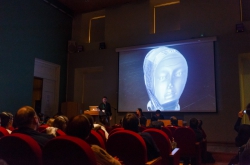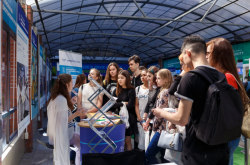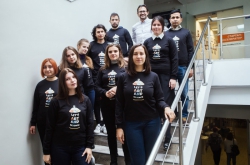In late 2016, State Hermitage's Department of Contemporary Art and ITMO University launched a joint project on the interaction of art and science, which offered workshops led by international guest lectures. Was it back then that you came up with the idea of launching a Master's program in this field?
We indeed invited important speakers in the field of Art&Science for our project. Actually, we could call it a test. First of all, we checked the number of people who come to us, the frequency of their visits, their feedback, i.e. we aimed to learn whether such a project can be interesting to a wide audience. Having successfully completed it, we could say that Art&Science is really a relevant topic. So, taking the next step was logical.
Also, when you work at a large institution, like a museum where you have all possible opportunities, it's easier to tell what you lack. This is why developing such a field as Art&Science seemed all the more important. For now, the interaction between art and science is only superficial: conservation professionals use particular data provided by scientists, and scientists, in their turn, rely on miscellaneous facts from art studies.
Still, we already experience the necessity to combine these two fields and make it so that the research that scientists conduct becomes part of art studies right from the start. It's a common development trend, as we no longer have chemistry and biology as they are, but fields such as biochemistry, bioinformatics, and many more emerge at the interface of different sciences. And everything that has to do with non-science and arts develop and change even faster.

This will be the first Art&Science program in Russia. Which international counterparts did you use for reference? And how will this program be different?
Speaking of Master's programs in the field of Art&Science, that would be MIT's Art&Science program, the one at the University of Art and Design Linz (Austria), at Ohio State University, University of California, as well as at programs of such institutions as Nanyang Technological University (Singapore) and the famous Central Saint Martins in London. In one way or another, they all make use of the resources of the cities they are located in. What is more, all these universities focus greatly on science. Fields like bioart and virtual reality are also being actively developed.
On the whole, first programs in Art&Science emerged in the beginning of 20th century. For one, the first graduate school Art&Science was opened in Harvard in 1905. In the very beginning, such programs were either stories about scientists who used flashy pictures in order to sell their inventions, or about artists who tried to study science and ended promoting it.
As for us, we have a different task. We want to use our ground work in Art&Science to train the specialists of the future who will develop new art formats. Nowadays, it has become evident that it is the creative industry that sets the foundations for the future: what has become important are the ideas, those who develop them, the ways in which they are executed, and their format. If in the early 2000's, Art&Science was mostly about industrial design, it now has many more aspects.
What are the fields that already require such specialists? Or is the market where they can apply their skills yet to emerge?
This is a very important question, and here, we'll really be talking about creating new markets, and a new outlook. Today, we face a situation where we have to solve really pressing problems - the issue of virtual reality that is already here, and the worldwide population outbreak, and the fundamental problem of an object's value. On the other hand, we have the rapidly developing science. And we can not overlook it, as it is the new technologies that change our reality.

For me, who is working for a museum, there's also the issue that the future generations won't really discern things real from things virtual. A person who was born in the time of smartphones and the Internet won't exactly understand the difference between a real painting by Matisse and its high-precision image on a smartphone, all the more that they can use the device to study it in better detail. Thus, the value of the originals is gradually diminishing. And this is an evident problem that modern culture already faces.
In the future, there will be more challenges that have to do with social conscience in general. And that will be the reality that future specialists will have to deal with. Our program is aimed at training such specialists.
You've already mentioned that the existing Art&Science programs draw on serious scientific resources. What about the new program at ITMO University? Was it for that reason that you've decided to introduce it here?
To my mind, ITMO University has now become a really important institution. On one hand, it has strong competencies in IT-related fields and such classical technical subjects as optics, photonics, and robotics, and has many great laboratories. On the other, it is open to new formats of education and aims to establish ties with both Russian and international universities and companies. This attitude and willingness to change are what is really necessary in the modern world.
In this sense, our task is obvious. We want to create a full-fledged cluster, some sort of a hub that will give students who already have experience of working with projects in laboratories the opportunity to understand that similar things can be done in the field of Art&Science on an international scale.
Which fields do you want to start with?
At first, we will be focusing on competencies that we already have. Those are such fields as bioart, photonics, and optics. We also have to consider that every student comes to us with their own ideas and experience. This is why we will be accounting for this factor, as well.

How will you organize education on this program? Will it be more about theoretical research or project work?
The program's purpose is to combine all of these aspects. We have to give a keen understanding of the associated processes and converge the emerging new developments into technologies of the future. There's surely no way of doing that with the students attending lectures only and cramming theoretical materials.
The training process will be conducted as short presentations on key topics followed by practical sessions, workshops, and project work. This will give students an opportunity to choose the topics they need in order to progress and give them the most attention. Thanks to this approach, students will learn to both work in teams and conduct individual projects where it's up to them to decide which specialists to attract.
What about the lecturers? Are you planning to attract many international specialists?
We expect to have about 50% of them. Still, the immediate issue is not about inviting international specialists, which is not really a problem. Our task is to find specialists that are best suited for our purposes, and have competencies in the fields we are interested in.
As I've already mentioned, we stake a lot on the flexibility of our course. By all means, the course will have some basic structure, but we will definitely be giving the students much freedom. We will assess our students' progress, and if we see that the students are lacking in some field, we'll be able to react and invite a specialist to develop an additional course of lectures and practical assignments.

By all means, we plan to invite many charismatic lecturers. Our task is to provide students with knowledge in a range of relevant fields from which they will be able to choose the ones to their liking. What makes this project truly special for Russia is that we aim to organize the educational process in such a way that it would become possible to develop personalized educational paths for every student.
What is more, the program will be mostly in English. Nowadays, this language is indeed a modern lingua franca, a way to communicate with partners and enter the international community of Art&Science that brings together a vast amount of specialists, universities, and laboratories. Access to this community offers the opportunity to get the results we plan to achieve.
What are these results?
We expect that after completing the two years of the program, the students will develop their independent projects. In order to do that, they will have to come up with new ideas, discuss them, as well as understand the design process and the resources necessary. Our task will be to give them advice and maybe help to reshape their goals.
The resulting projects can be either theoretical research or technological solutions. The educational process will comply with the concept of problem-based learning, i.e. will be based on solving problems.
What about the graduates' competencies, and the application fields of their skills?
We aim to train versatile specialists who will possess three types of knowledge. The first is the general cultural knowledge that will let them generate intercultural interaction and manage it. It will have a lot to do with design thinking and optimizing information flows.
The other is soft skills that will help manage complex art projects; this module will allow them to establish professional interactions in a corporate environment. Lastly, that would be professional activities that offer general knowledge about the scientific worldview and help attain the desired goals.

How do you choose applicants that you will accept on the program? Which students do you prefer - those with good groundwork in technical fields or specialists from the fields of art and non-science?
For now, we are assessing the submitted applications. And I want to note that the first thing we do is ask them to describe what they want to get from this program, how they perceive their development in the field of Art&Science.
Thus, we don't just expect to get their CVs, but more or less detailed motivation letters and stories about their achievements in different fields. Our key selection criteria are the scope of knowledge, willingness to study and learn new things, and having already completed projects.
This year, we'll be accepting 16 students, and we hope to have 30 of them by 2019.
As for their background, we'll be accepting different kinds of students. We want to help those who want to develop in a particular field to continue on with their progress. For instance, to help artists learn which media and technological techniques can be useful for their needs, and teach technical specialists to understand the humanitarian context of their future activities and, for instance, visualize whatever they are working on.
First and foremost, we'll be helping our students to fulfill themselves, not train them to become streamlined specialists with a given set of static skills.




